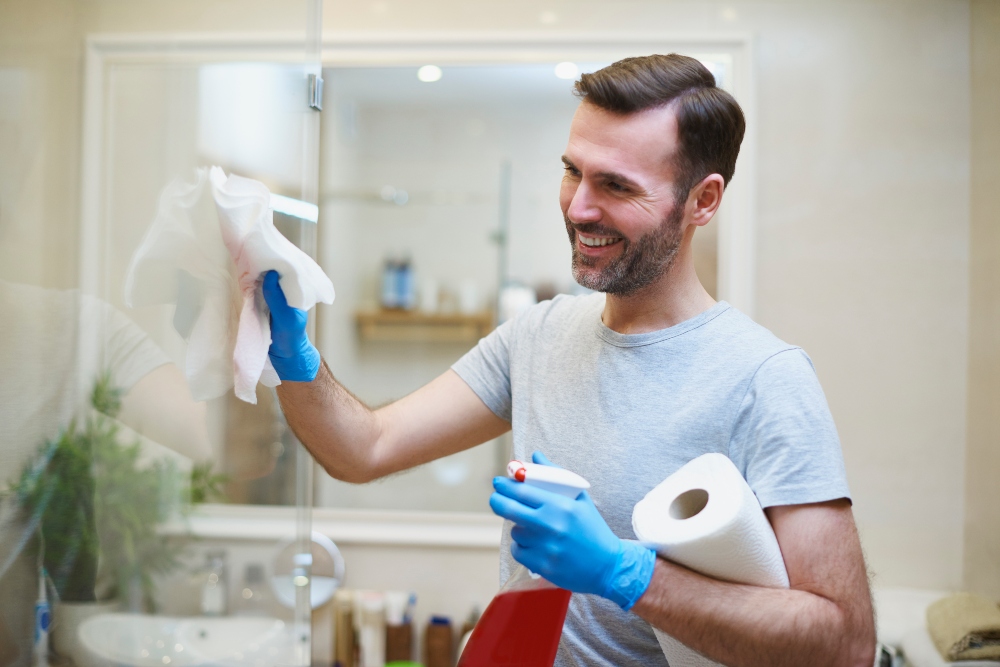
Happy man cleaning his home
Coronavirus has reminded everyone that germs are a risk everywhere we go. Whether you’re sheltering in place, need to leave for work as an essential employee, or just go out for supplies, you’re putting yourself and your household at risk. To lower the risk of bringing the infection home, pay special attention to the items listed below.
Touchable Surfaces
Coronavirus can live up to 72 hours on plastic and stainless steel. If the virus gets in your home, it may move from hand to surface, or it may cling to fabrics and shoes. Make sure you attend to shared, touchable surfaces at least twice a day. Take a spray bottle and mix 4 tsp of bleach with 1 quart of water. Put nothing else in this bottle, particularly nothing acidic like vinegar, and never ammonia.
Wear gloves and spray this product on a cotton rag. Wipe down
- door handles
- light switches
- shared keypads
- kitchen countertops
- dining room tabletop
- refrigerator and cabinet door handles
- microwave keypads
- faucets
- toilet handles
Basically, if multiple people touch a surface, make sure it gets disinfected multiple times a day. If any of these items would be damaged by bleach, spritz the area down with straight hydrogen peroxide and let it dry; peroxide works by exposure.
Things You Must Bring In Your House
Each day, you have to bring things into your house. Try to take care of as much containment as you can right by the door. Kick-off your shoes, take off your mask and put it either in a sealed trash container or a sealable bag for laundering. Wipe down your phone with an alcohol swab.
When you get home with groceries, place them on the counter, then wash your hands. If you want, wipe down containers with alcohol or other disinfecting wipes before putting things in the cupboard. Wash your produce in a bubbling food-safe soap, as bubbles serve to break down the lipid layer that protects the viral material. Once you have washed and rinsed your produce, you can put it into your storage containers or your refrigerator.
When it’s time to do laundry, try not to shake garments away from other garments. If you have laundry access in your home, consider doing a load or two every other day so garments to be washed don’t stack up and need to be handled multiple times. Use a normal amount of soap to break down the lipid layer on the virus, and if possible, use at least warm water on everything, and hot water if possible. If you choose not to dry things, run over them with a steam iron. In a household where multiple people are out every day, glove up to do laundry.
Try to Limit What You Bring in Your House
It’s important to note that viruses can’t move under their own power. They need a host to transport them. If you have to go to work every day and want to avoid restaurants, pack your lunch. Take care to use as much recyclable or disposable plastic cutlery, plastic bags, or recyclable foil, as you can. The more things you take out into the world, the greater a risk that you’ll come in contact with a water droplet containing the virus and bring it home.
Try not to wear a wide variety of shoes outside your home. If you need variety to maintain a professional image, leave a couple of pairs at the office that you can swap out and just wear one pair outside the house. Remember, coronavirus can survive in a water droplet for an extended period of time. Morning dew can create a damp sidewalk or parking lot, and one person’s cough or sneeze can come home with you. Again, when you get home, take off your shoes at the door so you don’t track any risk of the virus through your home.
COVID-19 is nothing to play with. Coronavirus is ending and altering lives around the world. In less than an hour a day, there are simple steps you can take to keep your home safe from the virus, or at least to reduce the risk of bringing the illness home.


